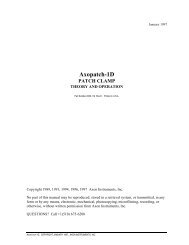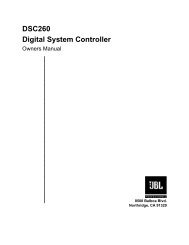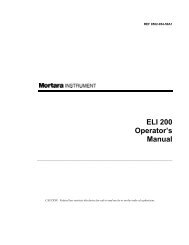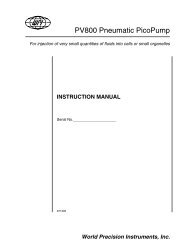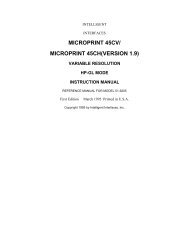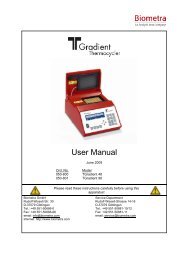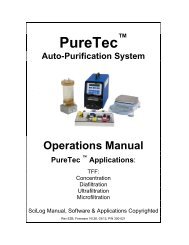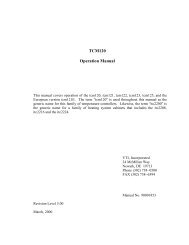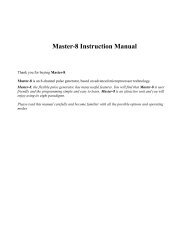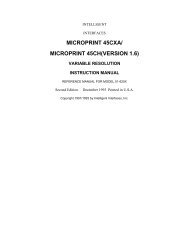Chromatotron
Chromatotron
Chromatotron
You also want an ePaper? Increase the reach of your titles
YUMPU automatically turns print PDFs into web optimized ePapers that Google loves.
Interrupting Solvent Flow. Solvent flow may be shut off for a considerable<br />
time during elution with no effect on the resolution ultimately obtained. If the<br />
flow is to be off for more than 20 min, increase the nitrogen flow to evaporate<br />
the solvent from the sorbent. The bands of compounds on the dry rotor will not<br />
spread by diffusion. The new solvent flow will sharpen the bands.<br />
Heavy Loading. For heavy loadings, dissolve the mixture in several ml of<br />
solvent. Concentrated solutions (>l0%) produce eccentric bands (due to the<br />
increased viscosity). Slight eccentricity is normal for heavy loading.<br />
Light Loading. Very small quantities of UV absorbing mixtures may not be<br />
detectable when spread out as circular bands on a rotor. More concentrated<br />
bands are obtained if the solution of the mixture is applied directly to the dry<br />
sorbent on the rotor as a single spot or a series of spots in a short arc. To<br />
observe the bands in UV light, turn off the solvent flow and stop the rotor.<br />
Choose a solvent which gives a low Rf so that equilibrium conditions will be<br />
attained before the compounds are eluted. Resolution of mixtures applied as<br />
single spots or short arcs is better than that from the complete circles of the<br />
normal procedure.<br />
Use thin sorbent layers to maintain higher concentrations of small samples.<br />
See the scraper blades in the CHROMATOTRON PARTS LIST.<br />
DETECTION OF UV ABSORBING COMPOUNDS ON THE ROTOR<br />
A UV lamp (e.g. a Mineralight, short wave, UVP Inc.) held over the Teflon lid of<br />
the <strong>Chromatotron</strong> will reveal bands of UV absorbing compounds. Bands will<br />
be visible directly under the lamp and also for some distance around the rotor<br />
due to the delay between absorption of UV and emission of visible light from<br />
the phosphor. Detection at short (254 nm) wavelengths is the most generally<br />
useful.<br />
A band of apparently even density will have most material near the center and<br />
very little at the leading and trailing edges. Two compounds that are 95%<br />
separated may therefore appear as a single broad band.<br />
For detection at the output tube, spot the eluate on a TLC plate held under a<br />
UV lamp. The lack of pressure at the output and the presence of gas bubbles,<br />
prevents direct connection to a UV monitor.<br />
Some hand lamps do not produce sufficient UV light, especially after long use.<br />
This problem is easily solved by removing the light filter (which absorbs most of<br />
the UV light). Shading the equipment from room lights will also give an<br />
improvement. A further enhancement can be obtained by turning off the<br />
solvent flow and stopping the rotor. If detection difficulties are due to a small<br />
sample size, see Light Loading, above.<br />
15



